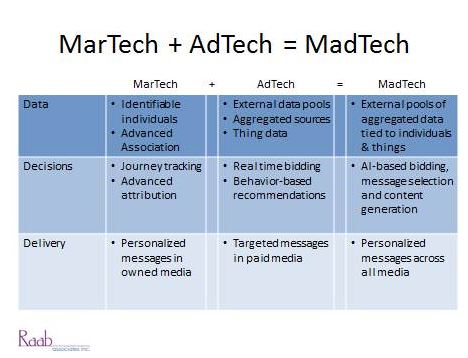The term “MadTech” might evoke images of the AMC show, Mad Men, which illustrates a wild and untamed advertising industry of the 1950s.
In reality, it doesn’t have anything to do with that era — well, except for the advertising part, of course.
(It also doesn’t refer to executives of New York’s Madison Avenue, which is who the term “Mad Men” reportedly describes.)
Actually, MadTech is a relatively new term used to describe something quite different but incredibly important: the convergence of online marketing and advertising technologies. You can download our ebook on this topic, here.
Because while marketing and advertising companies used to live in their own separate worlds, each offering unique tools and results for publishers, the line between the two has started to blur and creating a unique realm of marketing advertising and technology.
This shift in the landscape may be confusing at first, but it ultimately offers major benefits for publishers looking to better understand their potential customers, activate first-party data, and drive revenue from advertisers.
So, let yourself get swept up in the madness of MadTech.
Here’s what you need to know.
A definition of MadTech
The term MadTech was first coined back in 2015 by marketer consultant David Raab. He shared this MadTech chart via his Twitter, noting that MadTech combined the best assets of marketing advertising and technology. For example, it brings together the personalized, individual reach of MarTech with the massive data pools of AdTech. When marketing technology and advertising technology marry, publishers fall into a position where they can cultivate customers at every conceivable digital domain.

Raab also wrote of this MadTech convergence in an article:
“Even a fully integrated MarTech stack can’t deliver a wholly consistent customer experience. Advertising still plays a major role in a customer’s brand experience. Moreover, advertising itself is becoming increasingly personalized and interactive. Consumers don’t make a distinction between marketing and advertising interactions. And to meet their expectations, neither can marketers.”
The solution, Raab proposed, is the inevitable convergence of digital advertising technology and marketing technology to help companies “deliver a unified, consistent and highly personalized experience across all touchpoints.”
Why is this Convergence Happening?
Historically, AdTech and MarTech platforms have been two totally separate realms, but the two fields are extremely overcrowded. There are hundreds of technologies for each field. Yet, what we’ve realized is that both types of tech depend upon one another — plus, advertising and marketing are becoming a part of the same ecosystem. However, AdTech and MarTech platforms alone can’t be the all-encompassing technology that companies need today. Neither one covers the entire customer journey. This means that organizations need to invest in multiple platforms to do one main task: provide customers with seamless experiences online. The convergence of the two into MadTech will allow companies to invest in one technology to work in a more efficient and effective way.
With MadTech, strategic advertising technology and marketing technology come together to create unique, ongoing relationships with customers. This is the next frontier and brands who want to stand out need to step up to the plate to build a brand new marketing and advertising ecosystem that will benefit audiences and sellers alike by building a platform that caters to everyone’s needs and demands.
Take a big pot and stir in all these key ingredients, and you’ll end up with a killer MadTech platform. Remember MadTech builds on the successes of AdTech and blends them with MarTech, so the exact components might vary per strategy, client and customer.
The Components for MadTech
On the advertising side we have:
Demand-side platforms (DSPs). These platforms bring together digital advertising buyers through various ad exchanges and data sources in one interface. They utilize media buyers to run ad campaigns and rely on supply-side platforms and ad exchanges to get impressions. The data they obtain through ad brokers help demand-side platforms optimize campaigns and act through real-time bidding.
Supply-side platforms (SSPs) are how publishers sell their inventory to advertisers. These tools enable publishers to manage their advertising campaigns, run ads and get revenue.
An ad exchange is where the buying and selling of ad impressions happens. Offers are placed on DSPs and publishers post their sales inventory. Similar to a stock exchange, an ad exchange facilitates the buying and selling of ads in real time.
An ad network connects advertisers to websites with available ad space. The publisher can package and offer unsold ads to advertisers.
An ad server stores ads, decides where ads show up and collects and reports on the data. It’s basically an ad content management system.
Here are the main components of marketing technology:
Web-analytics tools collect and analyze data from websites and apps with the intention of improving user experience. It can measure how the marketing strategy is working
A customer relationship management (CRM) tool stores and oversees all of a company’s interactions with customers past, present and future. These tools might integrate data from other MarTech tools, like web analytics.
A customer-data platform (CDP) collects and stores first-party data so that marketers can view it all in one interface to create audiences and optimize the brand’s marketing strategy.
Social media management tools help marketers create, schedule and measure their social media campaigns. Some common tools are Hootsuite, Later, Sprout Social, Buffer and Reputology.
SEO and content-optimization platforms help marketers with search engine optimization, or how their websites and content rank on search engines.
Search-engine marketing (SEM) platforms deal with website visibility in paid search-engine results pages.
Performance tools, or customization engines, tailor website content to match the interests of individual users to create a more unique customer experience.
As you can see, there is plenty of overlap between MarTech and AdTech and how bringing them together can really improve outcomes for brands by utilizing technology to place the customer first.
Why MadTech is beneficial for publishers
There are many benefits of this new MadTech world for publishers, including these five:
1. Increasing personalization at scale: Publishers can harness the direct customer data from their owned platforms, like their websites and emails, and then use that data to launch personalized ad campaigns that nurture relationships and drive leads across digital spaces, such as social media.
2. Delivering more value to advertisers: MadTech takes publishers beyond traditional data, targeting, and audience segmentation solutions to help ad partners launch successful campaigns and meet their goals. And, in turn, publishers can drive greater ad revenue from their inventory.
3. Streamlining your tech stack: Publishers can get overwhelmed by the amount of AdTech and MarTech options out there. As a result, they might pile too many solutions into their stack, causing their data to become disjointed, their processes confusing, and their customers, well, misunderstood. Since MadTech combines the best of AdTech and MarTech, it can present publishers with one, comprehensive platform for their data collecting and targeting needs.
4. Breaking down internal silos: With that singular platform comes a more centralized and connected organization, making valuable customer data easily accessible across departments and campaigns.
5. Preparing for the cookiepocolypse: Publishers and advertisers have long relied on third-party cookies to track customer behaviors across the web. But those cookies have already been disabled on Safari and Firefox browsers, and are about to meet the same fate on Google Chrome browsers. As such, publishers and brands will start having to collect and activate their own first-party data through one-to-one, owned channels like email. MadTech solutions will allow marketers and publishers to more easily navigate this transition and exercise even more control over their customer data.
How to get started with MadTech
AdTech and MarTech are intersecting. If publishers want to survive — and thrive — they have to be ready to retool their marketing efforts with a new, combined approach to advertising and technology platforms. This perspective shift means the integration of MarTech platforms with a savvy ad network to build the ultimate management platform to reach users and make sales.
There’s one solution that publishers can use right now to get started with MadTech: multichannel messaging. It allows marketers and publishers to reach customers at scale in real time with personalized content meant just for them.
Multichannel messaging can also be monetized, helping publishers diversify their revenue sources and build direct relationships across high-engagement channels like email, push notifications, websites, social media, and news reader apps. With multichannel messaging, brands can follow users across the web by presenting detailed information and gathering data. It gives brands more exposure in a way that comes off as relevant and personalized.
What makes personalized, automated multichannel messaging possible?
Email.
Think about it. It’s an opt-in channel that delivers first-party data based on each individual user — not the browser they’re using or the device they happen to be on. That’s why, as a unique identifier, email is one of the most precious pieces of data you can collect about your customer — providing a more comprehensive view of their digital footprint and online behaviors. With the right type of web analytics, email can measure users and guide brands in developing effective engagement strategies that will lead to revenue. In addition, content optimization tools can help publishers craft the perfect messages for each audience, ensuring that each email makes a bigger splash.
Check out this video where I discuss the importance of email for owning your audience user data:
Email is the go-to bridge between advertising and marketing technology, and it’s the greatest tool today’s publishers have at their disposal. That is, if they want to master the new world of MadTech and get ahead of the competition.
Are you ready to be part of the MadTech revolution? Reach out today to get started.


